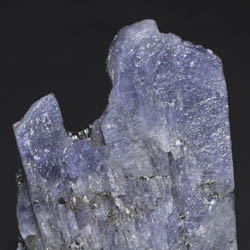Sign up for Lesson Plans, discounts & more!
Tanzanite
Rare Beauty

Tanzanite is just one of the many gemstone deposits that resulted from all the folding and faulting that took place there millions of years ago.
A relatively young discovery, This stone was first found in 1967 by an Indian prospector, Manuel de Souza. He first thought the bluish-purple crystals were olivine, but soon realized they were not. After a series of misidentifications by Souza and others, the gem was finally correctly identified as a variety of the mineral zoisite.
Officially called "blue zoisite," the gem was named Tanzanite by Tiffany & Co. Fearing the word “zoisite” sounded too much like “suicide” to carry much market appeal, they renamed the stone after Tanzania, whence it came.
In its rough state, it is usually a reddish brown color, but it is known and coveted for its remarkable pleochroism (that is, its ability to appear different colors when observed or lighted from different angles).
The three colors these chameleon stones usually display are blue, violet and a salmon-orange hue. Other colors may be faintly visible in the corners. Smaller tanzanite stones tend to appear more lavender, while those over 5 carats exhibit a rich hue that is most coveted.
The blues appear more evident when subjected to fluorescent light and the violet hues can be seen readily when viewed under incandescent illumination
This gem owes it popularity to their blue-violet color, the stones are heated to 500°F to eliminate the brown-orange color. Unlike other stones such as sapphires and rubies, which are heated to enhance their clarity, tanzanite is heated only to bring out its color, not to create higher quality.
Mining of this precious stone was nationalized in the early 1970’s. The industry now brings the Tanzanian government approximately $20 million (USD) net annually. Finished gems are sold mostly in the United States, their sales totaling approximately $500 million each year.
Rocks-Minerals Home |
Earth's Interior |
What Is A Rock? |
Igneous Rocks Metamorphic Rocks |
Sedimentary Rocks | The Rock Cycle
What Is A Mineral? |
Mineral Identification | Mineral Gallery | Rock Gallery
Lesson Plans | Crossword Puzzels |
Birthstones | Rock Links | Site Map

INTERESTED IN MORE? IF SO, YOU MAY WANT TO CHECK OUT OUR OTHER SITES:
fossilicious.com - Our online fossil and mineral rock shop.
fossils-facts-and-finds.com - An educational site about fossils.











